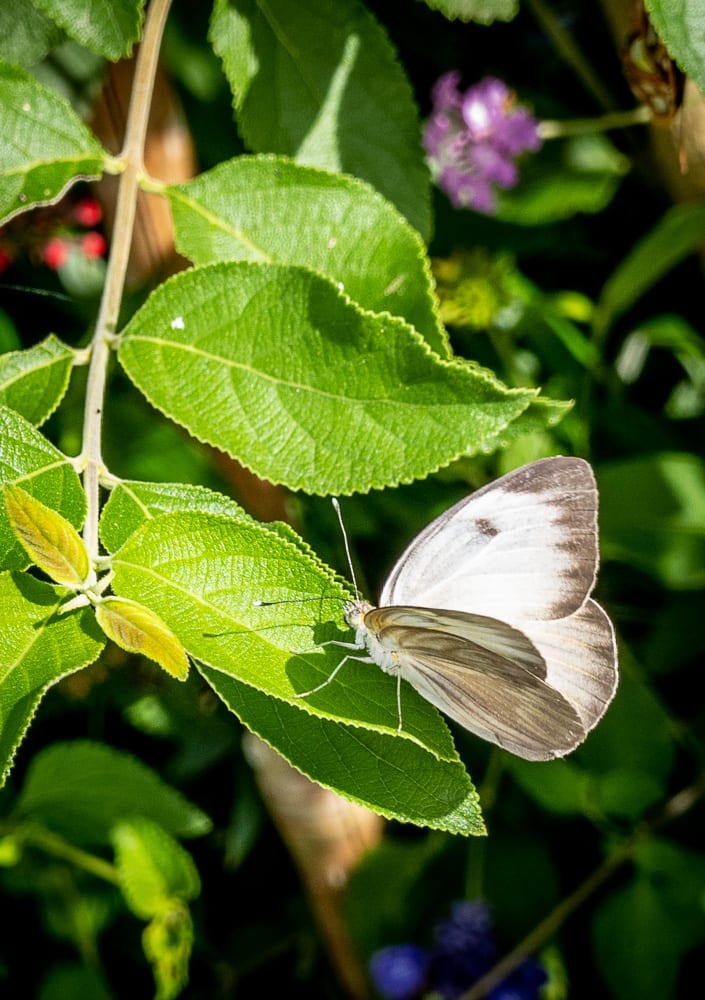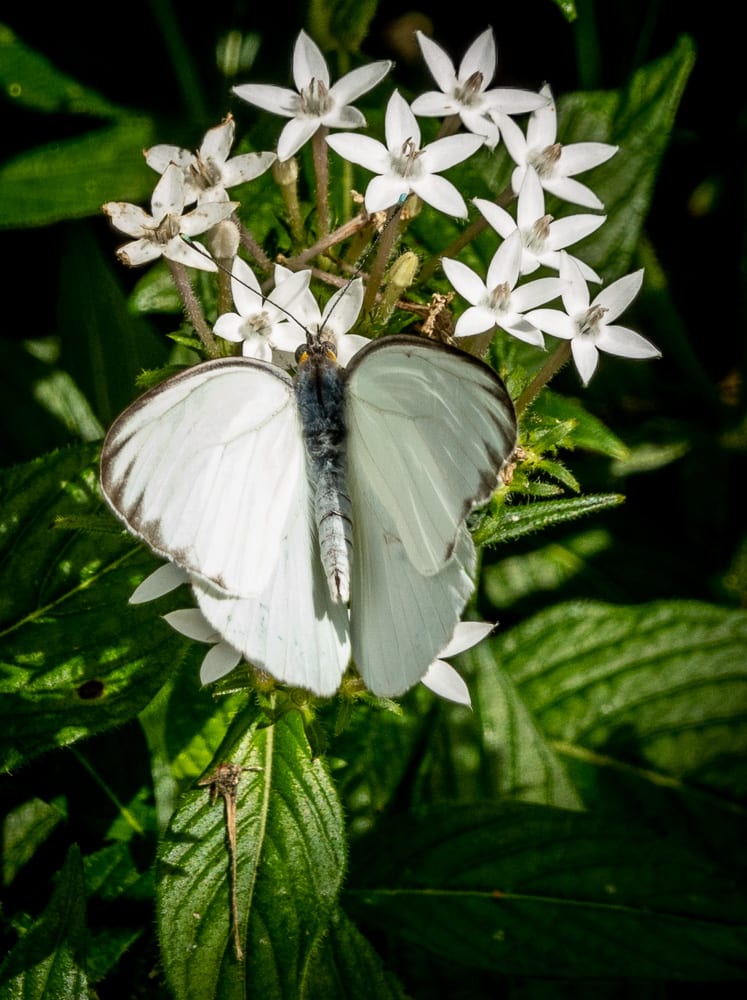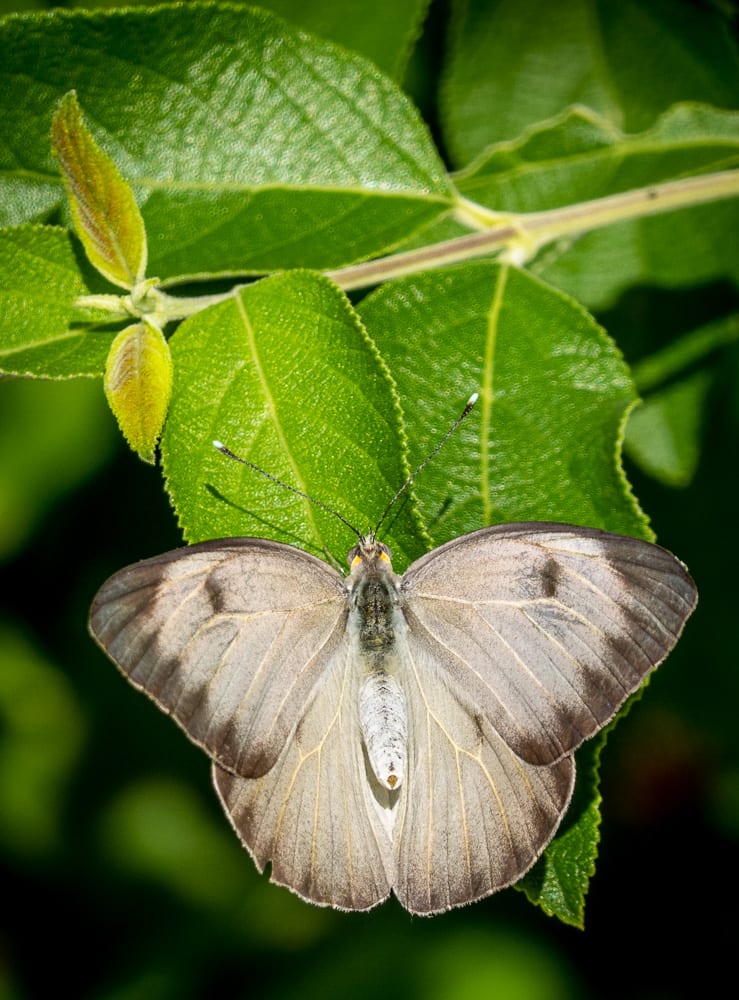


This elegant butterfly, with its pristine white wings and striking blue-tipped antennae, is a common yet captivating presence in the Sunshine State. From coastal dunes to backyard gardens, the Great Southern White is a testament to the beauty and resilience of Florida’s ecosystems. Let’s embark on a journey through the life, habits, and ecological significance of this charming butterfly, a true gem of Florida’s natural heritage.
A Graceful Appearance
The Great Southern White Butterfly is a medium-sized butterfly with a wingspan ranging from 2 to 3 inches. Its most distinctive feature is its pure white wings, edged with a delicate black border. The male’s wings are typically brighter, while the female’s wings may have a slight yellowish tint. Both sexes, however, boast the characteristic blue-tipped antennae that add a touch of elegance to their appearance.
When the butterfly is at rest, its wings fold vertically over its back, revealing the subtle gray or brown undersides. In flight, the butterfly’s graceful, erratic movements create a captivating display of white against the backdrop of Florida’s lush landscapes.
Habitat and Distribution
The Great Southern White Butterfly is primarily found in the southeastern United States, with its range extending from South Carolina to Texas and throughout Florida. It thrives in warm, coastal environments and is particularly abundant in areas with sandy soils, such as beaches, dunes, and scrublands. However, it can also be found in gardens, parks, and agricultural fields, demonstrating its adaptability to various habitats.
In Florida, the Great Southern White is a year-round resident, although its numbers peak during the warmer months. Its presence is a familiar and welcome sight along the state’s coastline, where it flits among the sea oats and dune vegetation, adding a touch of ethereal beauty to the seaside scenery.
Life Cycle and Behavior
The life cycle of the Great Southern White Butterfly is a fascinating journey of transformation, from egg to caterpillar to chrysalis to adult butterfly. Let’s explore each stage in detail:
Eggs: The female butterfly lays her eggs on the undersides of host plant leaves, typically in clusters of 10 to 50. The eggs are tiny, cylindrical, and pale yellow, gradually darkening as they develop. The primary host plants for the Great Southern White caterpillars are members of the mustard family (Brassicaceae) and the caper family (Capparaceae), including sea rocket (Cakile spp.) and wild radish (Raphanus raphanistrum).
Caterpillars: After about 4 to 5 days, the eggs hatch into tiny caterpillars, which immediately begin feeding on the host plant leaves. The caterpillars are green with faint yellow stripes running along their bodies, providing excellent camouflage among the foliage. As they grow, they go through several molts, shedding their skins to accommodate their increasing size.
Chrysalis: Once the caterpillar reaches its full size, it forms a chrysalis, attaching itself to a stem or leaf with silk. The chrysalis is green and blends seamlessly with its surroundings, providing protection during this vulnerable stage. Inside the chrysalis, the caterpillar undergoes a remarkable transformation, reorganizing its body into that of an adult butterfly.
Adult Butterflies: After about 10 to 14 days, the adult butterfly emerges from the chrysalis, its wings soft and crumpled. The butterfly pumps fluid into its wings to expand and harden them, a process that takes a few hours. Once its wings are fully formed, the butterfly takes flight, ready to continue the cycle of life.
Ecological Importance
The Great Southern White Butterfly plays a vital role in Florida’s ecosystems, contributing to pollination and serving as a food source for various predators. As adults, these butterflies feed on nectar from a variety of flowering plants, including lantana, verbena, and Spanish needles (Bidens alba). While sipping nectar, they inadvertently transfer pollen from one flower to another, aiding in the pollination process and supporting plant reproduction.
Caterpillars of the Great Southern White are herbivores, feeding on the leaves of their host plants. This feeding activity can help control the growth of certain plant species, maintaining a balance within the ecosystem. However, they are also preyed upon by birds, spiders, and other insects, making them an essential part of the food web.
In addition to their ecological roles, these butterflies serve as indicators of environmental health. Their presence and abundance can reflect the condition of their habitats, providing valuable information to conservationists and researchers about the state of Florida’s natural landscapes.
Historical and Cultural Significance
The Great Southern White Butterfly has been a familiar sight to the indigenous peoples and early settlers of Florida. Native American tribes, such as the Seminole and Miccosukee, would have recognized the butterfly’s seasonal patterns and its association with certain plants. The butterfly’s beauty and grace have long been appreciated, and it often appears in folklore and art as a symbol of transformation and renewal.
In modern times, the Great Southern White has become a beloved feature of Florida’s natural and cultural heritage. It is a popular subject for photographers, artists, and nature enthusiasts who seek to capture its delicate beauty and ephemeral presence. The butterfly’s role in pollination and its importance to biodiversity have also made it a focal point for conservation efforts, highlighting the need to protect and preserve Florida’s unique ecosystems.
Conservation and Challenges
Despite its widespread presence, the Great Southern White Butterfly faces several challenges that threaten its populations. Habitat loss due to urban development, agriculture, and coastal erosion is a significant concern. As natural areas are converted to other uses, the availability of suitable habitats for the butterfly decreases, making it more difficult for the species to thrive.
Climate change presents another looming threat, with alterations in temperature and precipitation patterns potentially affecting the butterfly’s life cycle and distribution. Extreme weather events, such as hurricanes and prolonged droughts, can also have devastating impacts on butterfly populations and their habitats.
Conservation efforts focused on preserving natural habitats and promoting sustainable land-use practices are essential to ensure the long-term survival of the Great Southern White Butterfly. Public education and awareness campaigns can also play a crucial role in protecting this species, encouraging people to appreciate and conserve the natural beauty of their surroundings.
A Personal Encounter
One of my most memorable encounters with the Great Southern White Butterfly occurred during a visit to a coastal dune habitat in the Canaveral National Seashore. The day was warm and sunny, with a gentle sea breeze rustling the dune grasses and wildflowers. As I walked along a sandy path, I noticed a flurry of white wings dancing among the vegetation.
I paused to watch the butterflies as they flitted from flower to flower, their delicate movements creating a mesmerizing display of light and color. One butterfly in particular caught my eye, its blue-tipped antennae gleaming in the sunlight. I followed its flight as it landed on a bright yellow sea rocket bloom, its proboscis unfurling to sip the nectar.
As I stood there, captivated by the butterfly’s elegance, I was reminded of the intricate connections that bind all living things. The Great Southern White Butterfly, with its role in pollination and its place in the food web, is a vital thread in the tapestry of Florida’s ecosystems. Observing this small but significant creature brought a sense of wonder and appreciation for the natural world and its countless marvels.
Conclusion
The Great Southern White Butterfly is more than just a beautiful insect; it is a vital component of Florida’s ecosystems. Its graceful appearance, fascinating life cycle, and important ecological roles make it a captivating subject for naturalists and nature enthusiasts alike. From pollinating flowers to serving as a food source for other animals, the Great Southern White contributes to the health and balance of its surroundings.
As we continue to face the challenges of habitat loss, climate change, and environmental degradation, it is crucial to recognize and protect the valuable contributions of species like the Great Southern White Butterfly. By preserving their natural habitats and promoting sustainable practices, we can ensure that future generations will have the opportunity to marvel at these remarkable creatures.
So, the next time you find yourself wandering through a coastal dune, garden, or park in Florida, take a moment to appreciate the Great Southern White Butterfly. Whether you’re admiring its delicate wings, observing its role in pollination, or simply enjoying the sense of tranquility it brings to the landscape, you are witnessing a living testament to the adaptability and resilience of nature. In doing so, you honor not only the butterfly itself but also the intricate web of life that it supports and the timeless connection we share with the natural world.
Ascia
Ascia is a genus of butterflies in the family Pieridae. It is monotypic, being represented by the single species Ascia monuste, commonly known as the great southern white,[2] In this species the sexes may differ with the female being either light or dark colored. It is found from the Atlantic and Gulf coasts of the United States, and south to Argentina. It is migratory along the south-eastern coast of the United States, with strays to Maryland, Kansas, and Colorado.
Larvae have distinct body segments within which there appears to be four to six subsegments. They are purplish-green with two longitudinal, greenish-yellow stripes on each side and the dorsal side. When full-grown, they are approximately one and a quarter inches long.[3] The wingspan in adults is 63–86 mm. Adults are on wing all year round in southern Texas, peninsular Florida and along the Gulf Coast.
A. monuste is a migrating species that moves in one direction within its life span and does not return. It breeds in Florida but sometimes migrates along the coast up to 160 km to breed in more suitable areas.
Life history
This species seeks out appropriate plant hosts for oviposition by detection of compounds called glucosinolates present in the family Brassicaceae.[4] Adults appear to prefer to lay their eggs on certain areas of the plant. On kale leaves, for example, the preferred regions are the apical, medium and basal parts of the leaves.[5] The average number of eggs laid is about 43 with as many as 245, being laid singly or in clusters.[6] A. m. monuste has been observed feeding on the chorion soon after hatching as their first food, as well as larvae feeding on eggs. It has been suggested that this behavior provides them with extra protein.[6] If a female oviposits on a plant already supporting conspecifics, cannibalism is more likely. Since they have a high growth rate and a non-regulated body temperature, herbivorous insects require a higher quantity of protein. It is questionable that A. monuste is strictly herbivorous as they often consume conspecific eggs.[7] Larvae have been seen consuming whole eggs from the same clutch or others nearby on the same leaf. This behavior appears to be advantageous from an evolutionary stand point as this is an opportunistic behavior and can increase fitness.[8]
In general, the development time for eggs ranges from 4–5 days in field conditions and 3.4 days in laboratory conditions. The developmental time for the larvae and pupae ranges between subspecies from 11.0– 17.4 days for the first five instars for A. m. orseis, and 6.1– 9.56 days for A. m. monuste. Pupation can be from 5.9 to 10 days long, and adults can live from 4.3 – 5 days for males and 8–10 days for females.
The larvae, known in Brazil as cabbage caterpillars [9] or kale caterpillars,[4] feed on Brassicaceae (including Cakile maritima, cultivated cabbage and radish and Lepidium species) and plants in the family Capparidaceae, including nasturtium. Chemical characteristics of the plant that affect the development of the larvae include the: nitrogen content, carbohydrates and water content, as well as physical characteristics such as: hardness, size, form, texture, temporal and spatial distribution and abundance. Nitrogen is required for the production of protein during the early instars.[10]
Newly hatched larvae will remain on a single plant, as they are not very mobile.[citation needed] After the 5th instar, they are more mobile and can move to another plant. Larvae dispersion appears to occur in a random fashion, so in order for the larvae to be successful, the plants need to be close together for them to find another plant. Intraspecific competition between larvae generally doesn't occur between the 1st and 2nd instars because they do not consume a lot.[9] Competition may become a problem once they hatch into the final three instars.[9] Adults feed on nectar from various flowers including saltwort, lantana, and verbena. It is a sporadic pest of crucifer vegetables in southern Texas.
Pest species of Brassicaceae
Damage to the plant is caused by the larvae that, upon hatching, feed on the leaves for almost the entirety of their developmental cycle.[11] This can be so damaging, that up to 100% of the entire crop can be lost.[citation needed] One method of decreasing this damage is by the use of pesticides. These, however can be detrimental to human health as well as the environment.[citation needed] Another method that is being explored is the use of host plant resistance, which is safer and more sustainable.[11] Resistant crops are becoming increasingly popular as pesticides have quite a few drawbacks. Resistance can be seen as antixenosis, tolerance and antibiosis.[12]
Subspecies
- Ascia monuste monuste (southern United States to Suriname)
- Ascia monuste phileta (southeastern United States, northern Bahamas)
- Ascia monuste virginia (Lesser Antilles between Virgin Islands and St. Vincent)
- Ascia monuste eubotea (Greater Antilles, Virgin Islands)
- Ascia monuste orseis (Brazil)
- Ascia monuste suasa (Peru)
- Ascia monuste automate (Argentina)
- Ascia monuste raza (Baja California Sur)
Gallery
-
Dorsal view
-
Ventral view
References
- ^ "NatureServe Explorer 2.0". explorer.natureserve.org. Retrieved 3 October 2020.
- ^ Hogue, Charles Leonard (1993). Latin American Insects and Entomology. University of California Press. p. 341. ISBN 0520078497.
- ^ Capinera, J. 2001. Handbook of vegetable pests. Gulf Professional Publishing.
- ^ a b Barros-Bellanda, H.C.H. & F.S. Zucoloto. 2003. Importance of larval migration (dispersal) for the survival of Ascia monuste (Godart) (Lepidoptera: Pieridae). Neotropical Entomology 32: 011-017.
- ^ Catta-Preta, P.D. & F.S. Zucoloto. 2003. Oviposition behavior and performance aspects of Ascia monuste (Godart, 1919) (Lepidoptera, Pieridae) on kale (Brassica oleracea var. acephala). Revista Brasileira de Entomologia 47: 169-174.
- ^ a b Liu, T.-X. 2005. Biology and life history of Ascia monuste monuste (Lepidoptera: Pieridae), a potential pest of cruciferous vegetables. Entomological Society of America 98: 726-731.
- ^ Zago-Braga, R.C. & F.S. Zucoloto. 2004. Cannibalism studies on eggs newly hatched caterpillars in a wild population of Ascia monuste (Godart) (Lepidoptera: Pieridae). Revista Brasileira de Entomologia 48: 415-420.
- ^ Santana, A.F.K., R.C. Zago & F.S. Zucoloto. 2011. Effects of sex, host-plant deprivation and cannibalistic behavior of wild Ascia monuste orseis (Godart) (Lepidoptera, Pieridae). Revista Brasileira de Entomologia 55: 95-101.
- ^ a b c Barros-Bellanda, H.C.H. & F.S. Zucoloto. 2002. Effects of intraspecific competition and food deprivation on the immature phase of Ascia monuste orseis (Lepidoptera, Pieridae). Iheringia, Série Zoologia 92: 93-98.
- ^ Bittencourt-Rodrigues, R.S. & F.S. Zucoloto. 2009. How feeding on young and old leaves affects the performance of Ascia monuste orseis (Godart) (Lepidoptera, Pieridae). Revista Brasileira de Entomologia 53: 102-106.
- ^ a b Baldin, E.L.L., E.C. Schlick-Souza, A.L. Lourenção & R.S. Camargo. 2014. Resistance of collard greens to Ascia monuste orseis (Lepidoptera: Pieridae). Arthropod-Plant Interactions 9: 67-74.
- ^ Schlick-Souza, E.C. & A.L. Lourenção, A.L. 2011. Variation in the host preferences and responses of Ascia monuste orseis Godart (Lepidoptera: Pieridae) to cultivars of collard greens Brassica oleracea (L.) var. acephala. Journal of Pest Science 84: 429-436.
External links
- Lotts, Kelly & Naberhaus, Thomas (2017). "Great Southern White Ascia monuste (Linnaeus, 1764)". Butterflies and Moths of North America. Retrieved January 7, 2020.
- Savela, Markku (November 27, 2011). "Ascia monuste (Linnaeus, 1764)". Lepidoptera and Some Other Life Forms. Retrieved January 7, 2020.


